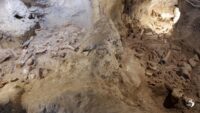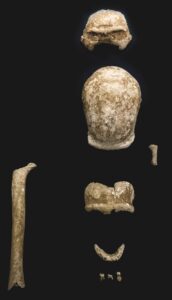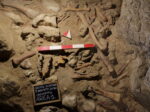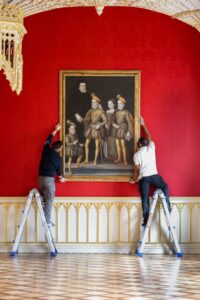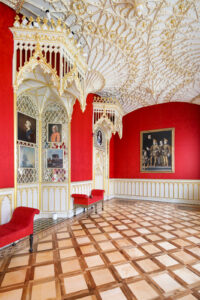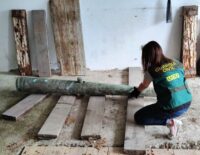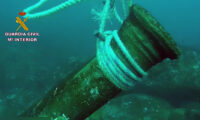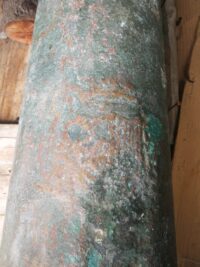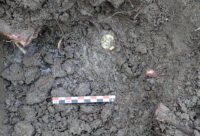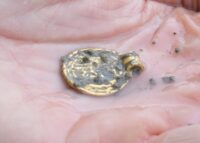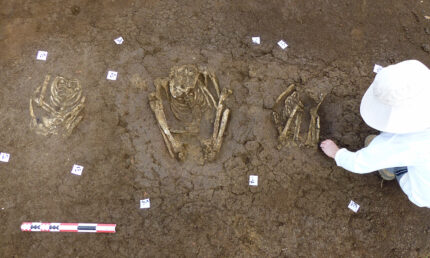 More than 100 pre-Columbian burials have been unearthed in the Les Abymes township of Guadeloupe. The discovery of so dense a concentration of pre-contact graves is without precedent in Guadeloupe. Agriculture and industry, primarily sugar cane production, in the colonial period damaged many of Guadeloupe’s pre-European archaeological layers, and most of what is known and recorded today is rock art and potsherds. Habitation sites are rare and human bone remains even rarer because of the high acidity of the volcanic soil.
More than 100 pre-Columbian burials have been unearthed in the Les Abymes township of Guadeloupe. The discovery of so dense a concentration of pre-contact graves is without precedent in Guadeloupe. Agriculture and industry, primarily sugar cane production, in the colonial period damaged many of Guadeloupe’s pre-European archaeological layers, and most of what is known and recorded today is rock art and potsherds. Habitation sites are rare and human bone remains even rarer because of the high acidity of the volcanic soil.
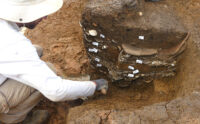 A team from France’s National Institute for Preventive Archaeological Research (INRAP) excavated the site of a future housing development and found filled pits and post holes, evidence of habitation from the later part of the Troumassoid Period (650 -1600 A.D.), between the 11th and 13th centuries. Several hundred post holes correspond to the numerous dwellings and there are about 50 pits that were used for domestic purposes. The fill in the pits contains pottery fragments, stone tools, heating rocks, animal bones and the remains of shellfish.
A team from France’s National Institute for Preventive Archaeological Research (INRAP) excavated the site of a future housing development and found filled pits and post holes, evidence of habitation from the later part of the Troumassoid Period (650 -1600 A.D.), between the 11th and 13th centuries. Several hundred post holes correspond to the numerous dwellings and there are about 50 pits that were used for domestic purposes. The fill in the pits contains pottery fragments, stone tools, heating rocks, animal bones and the remains of shellfish.
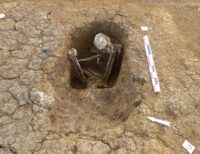 The burials were associated with this settlement. Skeletal remains of adults and children were found in a variety of positions: on their backs, semi-seated, seated and on their sides. The bodies were inhumed folded over on themselves. The arms were flexed over the abdomen, the legs pressed against the forearms, elbows or chest. The fact that the bones are still in these postures means the bodies were tied or placed in bags to ensure they stayed in place.
The burials were associated with this settlement. Skeletal remains of adults and children were found in a variety of positions: on their backs, semi-seated, seated and on their sides. The bodies were inhumed folded over on themselves. The arms were flexed over the abdomen, the legs pressed against the forearms, elbows or chest. The fact that the bones are still in these postures means the bodies were tied or placed in bags to ensure they stayed in place.
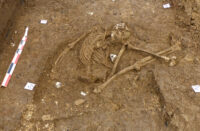 The habitations and burials form a unique database of information about ancient Guadeloupian communities. The remains will be radiocarbon dated and if possible DNA extracted. The condition of the bones in past finds made genetic analysis impossible, but the sheer quantity of burials here give archaeologists reason to hope that they might be able to figure out any familial relationships among the deceased. The pits and post holes will be analyzed to determine phases of occupation and construction, the layout and usage of the settlement. Researchers also hope to pinpoint whether the burials were contemporaneous with the occupation of the settlement or if they came later after the dwellings were abandoned.
The habitations and burials form a unique database of information about ancient Guadeloupian communities. The remains will be radiocarbon dated and if possible DNA extracted. The condition of the bones in past finds made genetic analysis impossible, but the sheer quantity of burials here give archaeologists reason to hope that they might be able to figure out any familial relationships among the deceased. The pits and post holes will be analyzed to determine phases of occupation and construction, the layout and usage of the settlement. Researchers also hope to pinpoint whether the burials were contemporaneous with the occupation of the settlement or if they came later after the dwellings were abandoned.
This research will help advance knowledge about the Late Neoindian period. This period is characterized by economic and cultural changes that took place around the 9th century throughout the Lesser Antilles archipelago, resulting from a process of regionalization of cultures, linked to the dispersion of groups throughout the Caribbean archipelago. Paleoclimatic changes identified in the Lesser Antilles doubtless also contribute to the cultural changes.
